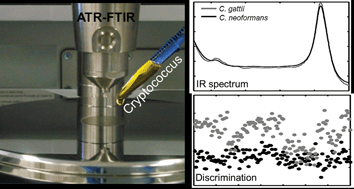Attenuated total reflection Fourier transform-infrared (ATR-FTIR) spectroscopy as a new technology for discrimination between Cryptococcus neoformans and Cryptococcus gattii
Abstract
Systemic fungal infections are among the most difficult diseases to manage in humans, especially when the recognition of the correct species is required for a precise and successful treatment. This is the case for Cryptococcus species and its genotypes, which are the main cause of meningitides in immunocompromised patients. Attenuated total reflection Fourier transform-infrared (ATR-FTIR) spectroscopy with discriminant analysis was employed to distinguish between the pathogenic fungal species Cryptococcus neoformans and Cryptococcus gattii by determining which wavenumber–absorbance/intensity relationships might reveal biochemical differences. Cryptococcus inactivated colonies were applied to an ATR crystal, and vibrational spectra were obtained in the ATR mode. Twenty-eight Cryptococcus isolates, fourteen C. neoformans and fourteen C. gattii were investigated. Spectral categories were analyzed using principal component analysis (PCA), successive projection algorithm (SPA) and genetic algorithm (GA) followed by linear discriminant analysis (LDA) and quadratic discriminant analysis (QDA). Multivariate classification accuracy results were estimated based on sensitivity, specificity, positive (or precision) and negative predictive values, Youden index, and positive and negative likelihood ratios. Sensitivity for C. neoformans and C. gattii categories were 84.4% and 89.3%, respectively, using a QDA-LDA model with 17 wavenumbers with respect to their “fingerprints”. Compared to classical methods for differentiation of Cryptococcus species, this new technology could represent an alternative and innovative tool for faster and cheaper fungal identification for routine diagnostic laboratories.


 Please wait while we load your content...
Please wait while we load your content...